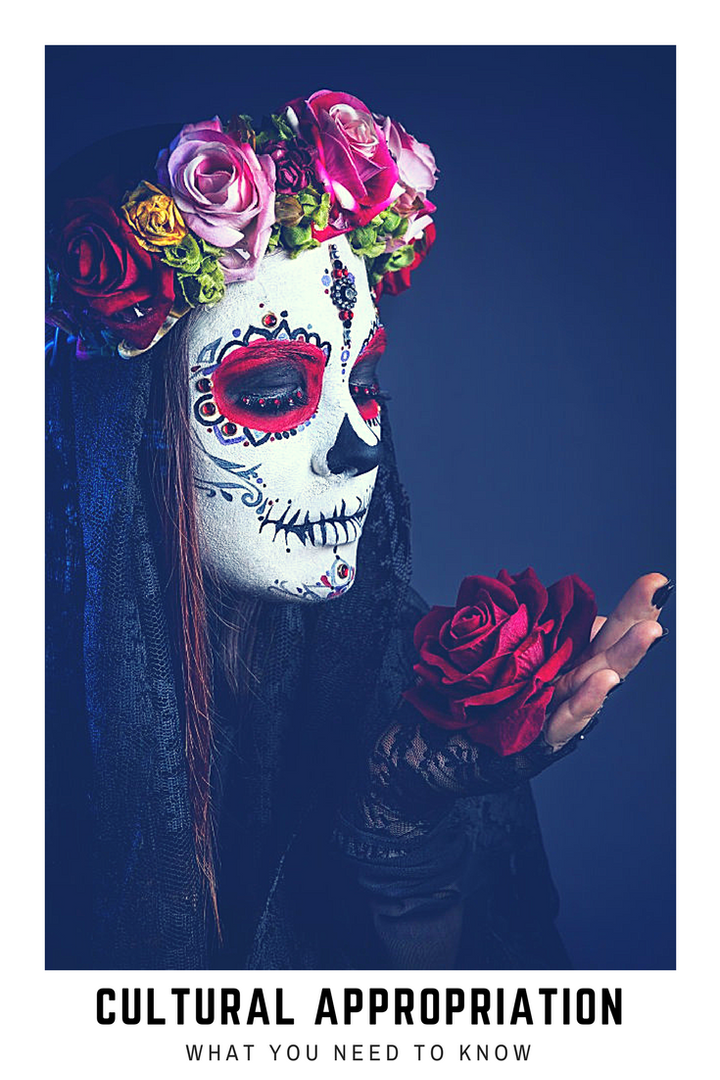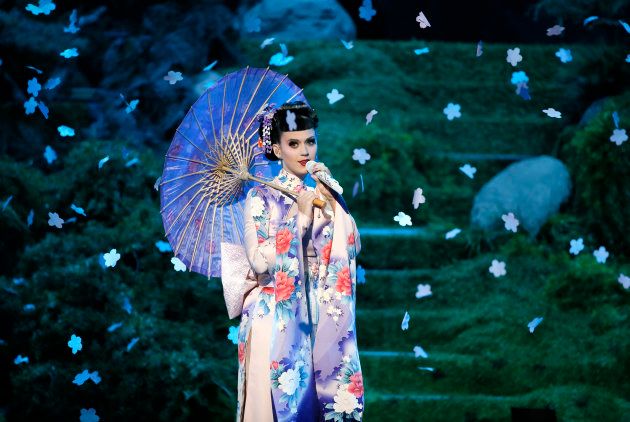
Cultural appropriation has been a hot topic of debate lately. Marc Jacobs sparked headlines around the world last year with his spring 2017 show which featured white models such as Gigi Hadid walking down the catwalk in fake dreadlocks.
In recent years so many people have worn Native American war bonnets and feathered headdresses to the popular Burning Man Festival, members of the Burning Man community (note: not the festival organisers, but the HYBYCOZO art crew who regularly contribute artworks to the event) wrote an opinion piece begging festival goers to 'listen up before dressing up'.
In May, Chanel came under fire for selling a boomerang 'accessory' for close to $2000; while Katy Perry was accused of appropriating Japanese culture due to her geisha-inspired performance at the American Music Awards.
While the media interest in the topic has some people throwing their arms up in the air and lamenting, 'am I not allowed to do anything anymore?', others would argue that it's a vital conversation well worth having, and having often. Particularly when incidents of blackface are still taking place, and let's all agree on one thing: blackface is not okay.
So ahead of Halloween, where dressing up in costume is pretty much mandatory (yes, yes, we know it's not an Australian tradition, but you can't sweep it under the rug completely) we thought we'd go back to the basics of cultural appropriation: what it is, how to strike a balance and the things you should definitely, definitely not dress up as next Tuesday.

What is cultural appropriation?
Cultural appropriation is defined as "the act of taking or using things from a culture that is not your own, especially without showing that you understand or respect this culture."
While this sounds simple enough, in our digital, globalised society the lines between something that's obviously offensive (blackface) and something that might be considered as embracing another culture (exotic cuisine) can be blurry.
"When I try to think about how to define it, the way I've come to now think of it is not necessarily so much about cross cultural engagement as it is an indication of a strong split that's going on," Dr Shameem Black from the department of gender, media and cultural studies at ANU College of Asia and the Pacific told HuffPost Australia.
"To me, the real split is between how enthusiastically a cultural product or process from a part of the world is received and how enthusiastically the people from that region are received."

When is cultural appropriation bad? Or not?
It's important to note that it's often perfectly okay to take on aspects of another culture. In fact, there are many benefits.
"I think the benefits are obvious. It can encourage creativity, for instance. There are lots examples in the history of art whereby people borrow from other cultures in a very creative way," associate professor at La Trobe University and author of 'Taking Responsibility for the Past', Janna Thompson, told HuffPost Australia.
"For example, Picasso did a lot of borrowing from African art, and Monet and many other artists were inspired by Chinese and Japanese art.
"Another benefit could be a kind of fostering of communication between cultures, especially if it's not all one way. People learning about the preconceptions and ways of thinking of a different culture through their art or other things that are appropriate.
"There are obviously benefits of appropriation and of course it can lead to people in countries, particularly third world countries, becoming known for what they do and appreciated for what they do.
"I think the word appropriation is loaded. It suggests exploitation or taking something away from somebody. I think of appropriation in a sense of making use of ideas and others is quite valuable. I think what's important is, first of all, consent."
When you look at the Native American headdress, we are talking about a group that has been dispossessed and dis-empowered, with many, many killed -- we're talking really serious histories of violence.Dr Shameem Black
Now this is where we delve into the balancing act between cultural appreciation and causing cultural offence.
"In general I think there is nothing wrong with cultures borrowing ideas [and] artistic styles from each other," Thompson told HuffPost Australia. "But there are two factors which can make this appropriation a 'rip off'.
"One is the commercial advantages that can be reaped by Westerners by 'borrowing' from traditional cultures or disadvantaged groups. The other is that traditional cultures often do not have the same ideas as Westerners about the role of cultural artefacts."
Take the Native American headdress, for example. Are many Native American communities benefiting from its worldwide commercial use? Probably not. And are the Native Americans thrilled about Americans (or others) pairing their traditional war bonnets with a silver bikini and fur boots for the ultimate Burning Man outfit? If you're unsure of the answer, listen to what Black has to say.
"When you look at the Native American headdress, we are talking about a group that has been dispossessed and disempowered, with many, many killed -- we're talking really serious histories of violence.
"So something as small as being able to make economic returns off this kind of interest... I can see how that becomes a real source of concern. That's not to say economic returns solve everything. I think some people would say, even if Native Americans were making money off it, it would still be problematic because of the histories of violence."
So, yeah. You might want to rethink the war bonnet as being this season's hottest festival accessory.
Black also makes the point that while some aspects of a culture are 'embraced' in Western society, the people from whom that practice or item comes from are not.
"I think where the energy behind cultural appropriation comes from is when people feel they've migrated from a part of the world -- so for example India, where my mother is from -- and people will often come and say, 'Oh today a cultural process like yoga is very popular in Australia and the U.S. That's wonderful.' But by the same token, many people who came from the Indian subcontinent are subject in 'other-ing' in these countries," Black told HuffPost Australia.
"I think there's a real question around 'Why is yoga more welcome than I am?' I think there's a lot of frustration around that.
"I want to make it clear I'm just speaking metaphorically [and using yoga] as a kind of rhetorical device, but it is true that a lot of these practices have become more commercially viable or moved into different economies than they once were in."

How can I appreciate a culture without appropriating it?
This is a good question, especially because many people aren't trying to cause offence, aren't profiting from anything and simply want to admire a culture that isn't theirs.
"I don't necessarily think there are wrong ways or right ways. Perhaps the most productive way to go about it is asking questions about when we are drawn to a culture or practice that isn't something we are automatically connected to," Black suggested.
"I think we can certainly use these opportunities to learn about histories and reflect on our own. How did we get to this point? That kind of self searching is really positive on an individual level and societal level."
But Black hesitates to draw a definitive line in the sand between the 'good' sort of cultural appropriation and the bad.
I will say I think it would be terrible if we only thought we are allowed to hold things close to us that are from our own culture.Dr Shameem Black
"I'm not sure there ever are lines," she said. "Or if there are lines, they are mobile and they will change as our conversations in society will change.
"I will say I think it would be terrible if we only thought we are allowed to hold things close to us that are from our own culture."
Thompson is more concrete.
"I don't think anyone should expropriate things without asking the people who created them for their consent," she said. "If they don't give their consent, you should try to communicate with them about what can be taken or used. And they should always get a proper return, if commercialisation is involved. As much as possible there should be a two-way equal exchange."
Not cool.
But what if you're just a Jane Doe, with no commercial interest?
"I think people should understand at least where these things come from," Thompson said. "For instance, most people would know it's wrong to blacken their faces because of the history, it's an insulting thing to do. People need to be aware of the history of these things and ensure they're not just insulting others."
And while you might be a small fry in the scheme of things, it doesn't mean you can absolve responsibility completely.
Does the culture you're interested in have a history of violence and/or oppression? Would an indigenous culture have benefit from the commercialisation of this particular product? Are you able to simply remove something when you get bored of it (for example, black face paint or a fake tribal tattoo) when others can't?
Which, finally, brings us to...
Halloween costumes (and all other forms of dress up)
We get it. Dressing up is fun, and pretty much the whole point of it is to be able to pretend you're something different to yourself. (Unless you're Kit Harington who went to a costume party as his own character Jon Snow, but that's another story for another time).
But can we please remind people of the literal MILLIONS of costumes you can dress up in that aren't offensive to others?
"When it comes to costumes, the problematic area seems to be people dressing up in costume form someone else's traditional culture," Jeffrey Browitt, associate professor in Latin American studies at the University of Technology Sydney told HuffPost Australia.
"And often people who dress up in costumes like that are not setting out to be insulting. But it can be insulting to the people whose culture they are mimicking.
"When you dress up as an American Indian on Halloween or do blackface or put on a hijab or something like that, that's when it becomes a question of cultural appropriation. Because often we are talking about people who are or have been an oppressed minority. If you are in the U.S. and are dressing up as a Native American, I would say that's highly offensive because of the power differentials."
Better.
You might say people are being overly sensitive, but as both Browitt and Black point out, it's a sensitive and uncertain time.
"In some ways we are seeing the failures of the promise of globalisation. It was meant to provide this easy wonderful borderless world, but the realities are much more complicated," Black said.
"There are very complex and often disturbing experiences people have had in the last few decades, and this question has now started to have an intensity [that wasn't there] when people were more optimistic where the future might go."
So. Costumes. Here's the lowdown.
"The best rule of thumb is to play it safe, dress up as a witch or a goblin and leave the ethnic costumes to one side," Browitt said. "No Indian headdress, no ethnic dress from cultures that don't belong to you in any way, and which, by the way, have nothing to do with Halloween. Halloween is a pagan Celtic tradition, so if nothing else [ethnic dress] would be inappropriate for the occasion, anyway."